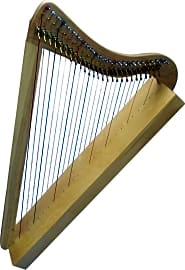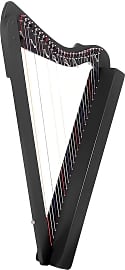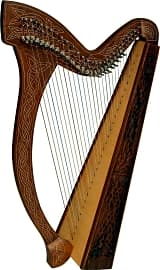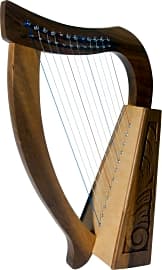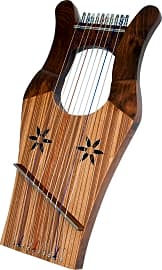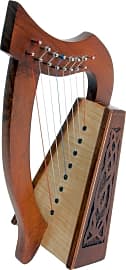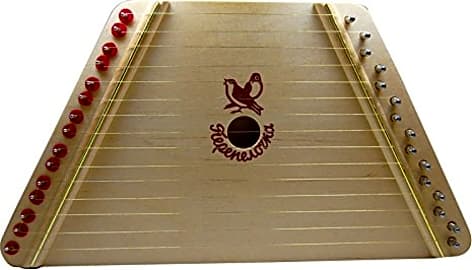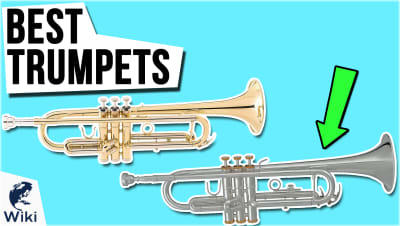The 10 Best Harps

This wiki has been updated 39 times since it was first published in June of 2016. There may be no other instrument in the world that sounds as enchanting as a harp. So, if you fancy trying your hand at its elegant tone, or you know of a budding harpist whom you want to encourage in his or her musical career, check out our comprehensive selection. We've included models suitable for beginners — including portable ones — as well as more professional options. When users buy our independently chosen editorial picks, we may earn commissions to help fund the Wiki.
Editor's Notes
May 12, 2020:
With the sheer breadth of options on the market, picking the right harp will have as much to do with its objective quality as it will your intended uses. A professional like Joanna Newsom, for example, couldn't rightly tour with something as dainty as the Roosebeck Lily, but a beginning player might use something that size to decrease their investment while building up both calluses and a bit of plucking technique.
Serious players will scrutinize things like lever quantity and wood quality, as well as knotwork in the case of Celtic models like the Mid-East Minstrel 29. And make no mistake: there are no easy-to-tune harps. Though there are some that will hold their intonation longer than others, allowing you to focus on your practice instead of spending hours each day getting the tone just right. Either way, it's always a good idea to check whether a model includes a tuning machine, as no stringed instrument can safely ship with its strings taut to a tuned position; it would put too much stress on the body of the instrument.
Special Honors
Lyon & Healy Premium These are some of the finest examples in the world, with 47 strings for a wide expressive capability. Each model is made from Sitka Spruce from the northwestern United States, and is finished with 23 karat gold. They're as much pieces of art as they are playable instruments, and their astronomical pricing bears that out. lyonhealy.com
Stoney End Floor This company offers varying degrees of customization with each of their models, allowing you to take a base selection in a wood of your choosing and add certain lever packages to make it suitable to your tastes. There are two capable four-octave models to choose from, as well as one four-and-a-half-octave unit that costs a bit more. stoneyend.com
A Brief History Of The Harp
However, harps were still relatively simple devices that couldn't easily switch between keys, and thus a player had to retune it for every new piece.
While stained glass windows portraying angels clutching stringed instruments might have you thinking harps initially descended from the heavens, it’s actually far more likely they evolved from primitive hunting bows. It’s not difficult to imagine an ancient hunter thumbing his bowstring and delighting in the musical note it produced. These humble beginnings kicked off thousands of years of development and ingenuity across myriad cultures.
Archaeologists discovered the remains of early harps in royal tombs and burial pits located in Sumer circa 3500 B.C.E. When they excavated the city of Ur in the 1920s, they unearthed stringed instruments shaped like bulls. Additionally, harps and their variants have been depicted in numerous paintings and written accounts, including Egyptian cave murals that date back to 3000 B.C.E. It would require another 1,000 or so years for the instrument to begin taking on a more angled shape, and still thousands more to resemble what we're familiar with today.
Eventually, manufacturers added front pillars to help ease the tension brought on by additional strings, and by the Middle Ages, the three-part design had risen to prominence in Europe. The materials used for strings graduated from plant fibers to resilient brass and copper, which resulted in greater volume and a longer tone. However, harps were still relatively simple devices that couldn't easily switch between keys, and thus a player had to retune it for every new piece.
This would change in the 17th century with the addition of metal catches that could tighten each string and raise its pitch a half-step. This was a huge improvement, but nevertheless, harps still required a lot of tuning.
Players craved an even broader range, and thus pedals began to appear on the bases of harps around the 1770s. They connected to metal rods that ran through the column to the neck, where they would tug on hook mechanisms attached to corresponding strings. These single-action harps were capable of playing in eight major and five minor keys, and they attained immense popularity over the following decades.
In the early 1800s, instrument maker Sebastian Erard worked for years to redesign the existing pedal scheme. He eventually engineered a mechanism that could shorten any string by one or two semitones, thus enabling harpists to perform in any key. He received a patent for his work in 1810, and the concert harp we're familiar with today was born.
Which Harp Is Right For You?
Harps come in a wide array of shapes and sizes to suit every age and playing level. If you’re an ambitious beginner looking for something to practice on, consider a lever harp. This style is what's known as diatonic, which means it’s limited in the number of keys it can play. Despite this, it still presents a suitable challenge to a newbie. A 34-stringed model is good for those that want to transition to advanced playing, while a 26-string design is great for practicing alone or musicians who travel often.
If you’re an ambitious beginner looking for something to practice on, consider a lever harp.
Those who are simply looking to tinker around might want to consider smaller, less costly 12-string styles or lap harps, which are still capable of producing a beautiful sound. They’re advanced enough to give you plenty to work with, without all the stress that comes with the maintenance of their more complex cousins. Children may require a model that rests on the floor, as handheld versions can be trickier for them to play.
Of course, seasoned professionals will almost certainly want to play a concert harp. These are capable of performing in any key and musical style and are typically very expensive.
In the end, you’ll want an instrument that is not only in your price range and appropriate for your experience level, but also capable of helping you reach your goals. Choosing a harp is a very personal decision, and it’s best to opt for a model that's adequately suited to your individual lifestyle.
Caring For Your Harp
A harp is an investment that can you can enjoy for decades if you take proper care of it. While you'll need to be diligent when it comes to your instrument's maintenance, the tasks involved are easy enough to perform. The following tips will help ensure your instrument has a long, full life.
Where you store your harp is crucial to its health. To prevent the wood from drying out, you’ll want to keep humidity levels close to 50 percent if you can — a simple monitor placed nearby can help you gauge the situation. It’s also smart to consider investing in a humidifier if you live in a dry climate.
The following tips will help ensure your instrument has a long, full life.
Never leave your instrument in direct sunlight or expose it to extreme temperatures. Fluctuations in the conditions surrounding your harp can affect how well it stays in tune and the integrity of its strings. Also, take care to keep it in a low-traffic area that's well out of the way of children and pets. A good rule of thumb is to always have it backed into a corner when not in use.
When transporting your harp, refrain from placing it in a hot car. Instead, move your vehicle to a shady spot, roll the windows down, and get the AC going. This is imperative, as high temperatures can cause the glue joints to soften and the wood to crack. Always lay it on a flat, padded surface with the sharping levers facing up.
Your harp has most likely been treated with a lacquer that will protect it from accidental smudges and your skin’s natural oils. When you want to wipe away finger marks or dust, use a lint-free, non-abrasive cloth made from cotton or a similar fabric. To avoid scuffing the wood or snagging the strings, remove any clunky jewelry before playing.
Try to tune and play your harp regularly to keep the tension even and ensure it’s in good form. Never leave your tuning wrench to rest on a tuning pin for a long period of time, as it can easily fall and damage your soundboard. By simply following a few common sense guidelines, you’ll be able to enjoy your instrument for years to come.



